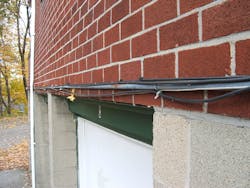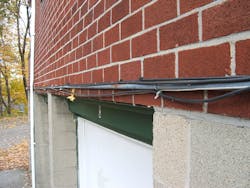Hint: Communications breakdown
See the answer below.
This type of installation is an all-to-common sight for me. The installer of the CATV and communication cables took the easy way out and simply hitched a ride along the existing raceway. While some of these cables appear to be supported independently of the metal raceway, there are some that are secured to the raceway itself.
Section 800.133(B) prohibits communication cables from being strapped, taped, or attached by any other means to the exterior of raceways as a means of support. In the same fashion, Sec. 820.133(B) prohibits coaxial (CATV) cables from being secured to the exterior of raceways as a means of support too. Independent supporting means must be provided for these cables.
While Sec. 800.24 and Sec. 820.24 both make reference to Sec. 300.11, the rules in 300.11(C) would not be applicable in this situation since these cables are not Class 2 circuit conductors installed for controlling equipment connected to the raceway.
About the Author

Russ LeBlanc
Owner
Russ started in the electrical trade as an apprentice in 1985. He worked his way up to become a Journeyman Electrician and then eventually became a Master Electrician and Licensed Construction Supervisor. In 1999 Russ become an Electrical Instructor for The Peterson School of Engineering in Massachusetts where he developed his passion for teaching, and quickly became Department Head of Electrical Instruction. Russ has taught thousands of apprentices, electricians, engineers, inspectors, and other electrical professionals during his career as an instructor. He continues to provide electrical professionals with Electrical Code seminars, Arc-Flash Awareness training seminars and educational material through his LeBlanc Consulting Services in North Reading, MA whose specialty is educating electricians. He has been an active member of the NFPA Electrical Section and has authored hundreds of National Electrical Code proposals and comments which have become Code rules to improve the safety for the electrical industry. Russ is also an IAEI certified Electrical Inspector.
Please visit www.russleblanc.net for more information.

